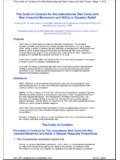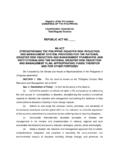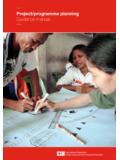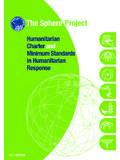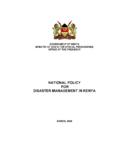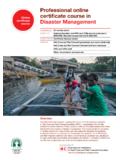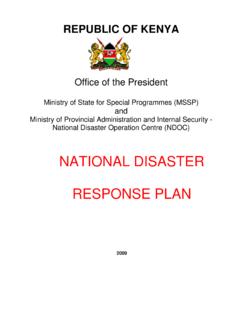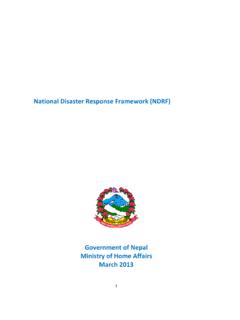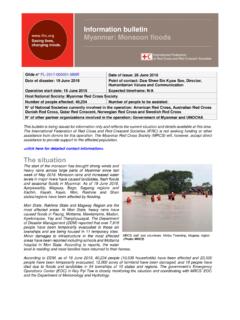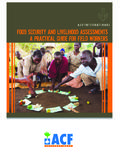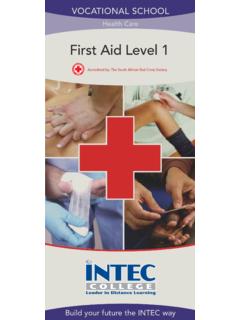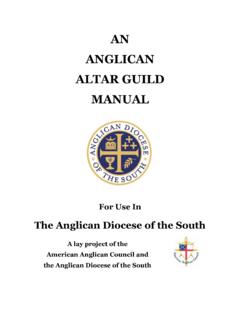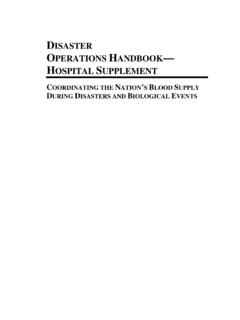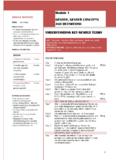Transcription of IFRC Recovery programming guidance 2012
1 ifrc Recovery programming guidance 2012 How we work International Federation of Red cross and Red Crescent Societies, Geneva, 2012 Any part of this publication may be cited, copied, translated into other languages or adapted to meet local needs without prior permission from the International Federation of Red cross and Red Crescent Societies, provided that the source is clearly stated. Requests for commercial reproduction should be directed to the ifrc at photos used in this study are copyright of the ifrc unless otherwise indicated.
2 Cover photo: Box 372CH-1211 Geneva 19 SwitzerlandTelephone: +41 22 730 4222 Telefax: +41 22 733 0395E-mail: site: 2020 voices the collective determination of the ifrc to move forward in tackling the major challenges that confront humanity in the next decade. Informed by the needs and vulnerabilities of the diverse communities with whom we work, as well as the basic rights and freedoms to which all are entitled, this strategy seeks to benefit all who look to Red cross Red Crescent to help to build a more humane, dignified, and peaceful the next ten years, the collective focus of the ifrc will be on achieving the following strategic aims:1.
3 Save lives, protect livelihoods, and strengthen Recovery from disasters and crises 2. Enable healthy and safe living 3. Promote social inclusion and a culture of non-violence and Federation of Red cross and Red Crescent SocietiesIFRC Recovery programming guidance Box 372CH-1211 Geneva 19 SwitzerlandTelephone: +41 22 730 4222 Telefax: +41 22 733 0395E-mail: site: International Federation of Red cross Red Crescent Societies ( ifrc ) and its member National Societies represent the largest humanitarian net-work in the world delivering humanitarian assistance to vulnerable people to save lives, protect livelihoods and strengthen Recovery from disaster and crisis as outlined in Strategy 2020.
4 These guidelines have been developed in line with our commitment to strengthen and continually improve Recovery programming based on the disasters and crises of today and learning from our experiences and efforts up to this affect people s lives by destroying life, property and the ways in which people support themselves. Recovery is what individuals, communi-ties and institutions start to do straight after the disaster, relying on their own skills, experience and resources to rebuild their lives. Recovery in the context of disaster response is a process that results in people s lives re-turning to normal in such a way that they will have more resilience to future disasters.
5 The extent to which people can recover after a disaster de-pends on their situation beforehand and how resilient their resources are to withstand the effects of a disaster. For some Recovery will be relatively quick, while for others it may take programming for the ifrc refers to an approach of how people are supported following a disaster, and starts early, alongside relief. It borrows ways of working from longer-term sustainable development and adapts them to a humanitarian context. As individual and community needs are diverse, a Recovery programme should cover a range of differ-ent responses and sectoral areas.
6 A well-integrated Recovery programming approach works in a participative, inclusive, accountable way that does no guidelines help to describe the main elements of a Recovery pro-gramming approach required to deliver high-quality, timely and account-able humanitarian assistance. They were developed under the guidance of a steering group comprised of ifrc management and technical staff and key National Societies, as well as with substantial consultation from the Red cross and Red Crescent Movement and the wider humanitarian Foreword2 International Federation of Red cross and Red Crescent SocietiesIFRC Recovery programming guidance sector.
7 An accompanying training package can be found on the Recovery page of the Federation s Disaster Management Information System (DMIS). The comprehensive training package has been designed with the goal of providing disaster management practitioners with skills and confidence to facilitate a better common understanding of what a Recovery program-ming approach means for the intention is to update the guidelines every two to four years or as nec-essary on the basis of user feedback. Therefore we would request that ifrc staff and volunteers who use these guidelines note what was helpful, what was not, and any additional material that should be included in future editions.
8 Your feedback is welcome via the Recovery page of the DMIS or directly to the Senior Officer Recovery , Disaster and Crisis Management department. We look forward to hearing from you and trust that you will find these guidelines relevant to improving our work with vulnerable and disaster-affected Cotte WitinganUnder Secretary General, Program Services DivisionInternational Federation of Red cross And Red Crescent SocietiesForeword3 International Federation of Red cross and Red Crescent SocietiesIFRC Recovery programming guidance Table of contents Foreword 1 Table of contents 3 Acknowledgements 7 Acronyms 8 Key Recovery programming principles 9 Glossary 13 Section 1: Introduction 21 Who is this guide for?
9 22 When should this guide be used? 23 How should this guide be used? 24 References 26 Section 2: Understanding the approach to Recovery programming 30 Definitions 31 The Recovery programming approach and ways of working 34 Recovery and disaster management 36 Disaster relief and early Recovery 40 (sudden onset and slow onset disasters) Recovery and the longer term 43 Red cross Red Crescent Movement added value 44 Summary conclusions 45 Recovery approach checklist 46 Table of contents4 International Federation of Red cross and Red Crescent SocietiesIFRC Recovery programming guidance Section 3.
10 Key strategic issues to guide Recovery programming 47 The operational strategy 48 Building the Fundamental Principles and Recovery ways 51 of working into the programme Building systematic analysis into the programme 52 Building the strengthening of resilience into the programme 53 Building sector integration into the programme 54 Building an analysis of cross -cutting issues into the programme 56 Building innovative approaches to disaster management 59 into the programme Building stronger coordination into the programme 64 Building sufficient resources into the programme 67 Increasing the organizational development of the National Society 68 Summary conclusions 71 Section 4: Practical application of the Recovery approach 73 to the programme cycle Working with communities 75 Step 1: Assessment and analysis 82 Step 2: Planning and design 100 Step 3: Implementation 109 Summary conclusions 114 Annexes.

